Deepened international collaboration for destruction of ISIL: Desired outcome of G7 Summit
Ikuzo Kobayashi, President of NPO Salaam Association
From the Summer Issue of the electronic Salaam Quarterly Bulletin, No.18, May 2016
A series of ministerial-level meetings leading to the upcoming Group of Seven Ise-Shima Summit at the end of May have started. It is strongly desired that Japan as the host nation achieve successful results in deepening international collaboration as the world community faces tough issues. First, the summit should agree on the roadmap toward “the world without nuclear weapons.” Second, the summit should agree on the roadmap toward destruction of the extremist group, the Islamic State (ISIL). This article focuses on the latter.
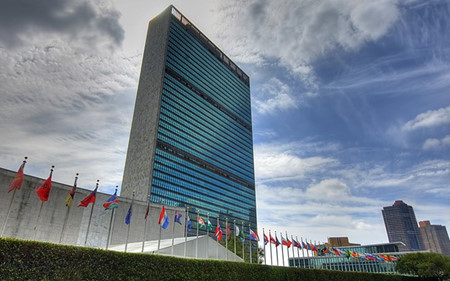
The Headquarters of the United Nations in New York
Conscience of humanity demonstrated by the end of the global confrontation between democratic and communist blocs

Bush and Gorbachev at the Malta summit on December 2, 1989, on a Soviet cruise ship, Maxim Gorki
After the World War II, the world community has been in search for a transnational world federation based on the ideal of one world family. That ideal has taken roots in our conscience generation after generation and provided the ethos for realization of the ideal. The Cold War between democracy which honors and values religion and spirit and materialism which is based on atheistic materialism ended after the Malta Summit held in December, 1989. As the result, a global nuclear war between two superpowers, the United States and the Soviet Union, was averted. Subsequently, the Soviet Union recognized religious freedom and terminated a communist system. The Soviet Union collapsed.
It can be said that the world has come to a stage to implement a roadmap toward a transnational world federation, a system more ideal than the United Nations, centered on the UN.
East European conflicts after the end of the Cold War

The Headquarters of the European Union in Brussels.
In the wake of the end of the World War II, many ethnic groups formed independent nations and increasing number of nations joined the United Nations. After the end of the Cold War, ethnic and religious confrontations within independent nations have been causing breakup of nations and formation of new national boundaries continuously. The collapse of the Soviet Union gave birth to Russian Federation and independent states in the CIS. The nation of Yugoslavia subsequently broke up. Those nations had been incorporated into a federation of nations which was formed by socialist or communist ideology before those individual nations reached full maturity based on their ethnic and religious identities. Formation of new nations after the Cold War was facilitated by their weakened link to a federation and their drive for new ethnic and national identities. While those nations are maturing as an individual nation, they seek to join the European Union and support formation of a transnational world federation.
Unilateral declaration of the establishment of a nation by the Islamic State (ISIL)
In June, 2014, the ISIL group declare to establish a nation based on their control over some territories in Iraq and Syria. This happened shortly after the United States and European nations imposed economic sanctions against Russia for their action of claiming sovereignty over the Crimean Peninsula. Because of this, there was deep concern about increased risk of liquefaction of national borders in Middle East formed after the World War I. Many were concerned about the possibility of breakup of nations and new conflicts in Middle East and Islamic regions which are different from breakup of nations in the central region of the Balkan Peninsula.
The United States’ response to ISIL
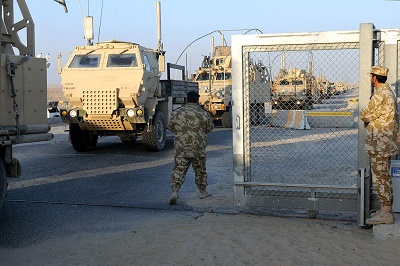
Kuwaiti soldiers look on as the last U.S. convoy crosses the border into Kuwait from Iraq, Dec. 18, 2011. U.S. Army photo by Cpl. Jordan Johnson.
The declaration of the establishment of the Islamic State as a nation was taken most seriously by the United States. This is because the United States was a nation which got involved in Middle East most deeply through the Gulf War in 1991, the Oslo peace accords in September, 1993 and the Iraq War in March, 2003.
The Iraq War was started due to suspicions about Hussein regime including the regime’s possible actions to allow Al Qaeda personnel to stay in the nation, possess and manufacture weapons of mass destruction and prevent the United Nations’ inspections. The United States was also expecting democratization of Iraq and other Arab nations in the vicinity as a result of the war. The United States destroyed Hussein regime by her military power, merely showed a roadmap toward democratization of Iraq, entrusted actual implementation of democratization to the newly formed Maliki regime in the post-war Iraq. In other words, the United States expected Maliki regime to govern Iraq successfully as a party responsible. The United States took a stance to concentrate on providing military support from the side. Accordingly, blaming the United States for the failure of Iraq democratization represents shifting the responsibility for the failure from the Islam-oriented nation of Iraq to the United States. The situation in Iraq then did not allow such carefree abandon attitude to indulge in discussion as to who is responsible.
In reality, al Qaeda-affiliated ISIL called itself as “Islamic State of Iraq” in October, 2006 and started implementing a strategy to control actual territories. Abu Bakr al-Baghdadi anticipated total withdrawal of the United States forces (which took place in December, 2011) and assumed the position of the Amir (commander) of the Islamic State of Iraq and appointed a former military officer of Hussein regime as his deputy in October, 2010.
President Obama’s response to ISIL

Former President of Egypt, Morsi
Obama administration regarded the Muslim Brotherhood as a non-violent (democratic) socio-religious movement and expected the group to lead the transition to an Islamic-style democratic nation. This was a grave mistake. Although the Arab Spring effectively contributed to collapse of a long-term dictatorship through a series of demonstrations by Arab masses, radical Islamists spun off from the Muslim Brotherhood ran amok unopposed in the aftermath of collapse of dictatorship. As a result, nations fell into great chaos rather than giving birth to democracy. A representative example is Egypt where President Morsi aligned with the Muslim Brotherhood came into power. In Tunisia, the Ennahda Movement affiliated with the Muslim Brotherhood was empowered. Although a moderate government acceptable to the United States and European nations was established in Libya, the nation turned into recruiting ground for radical Islamists and chaos prevailed.
In case of Syria, anti-government demonstrations escalated and radicalized under severe repression by the Assad regime. When Syrian government’s use of chemical weapons was revealed, President Obama had a chance to pave the way to the end of the civil war by military force but missed the chance. The Islamic State of Iraq took advantage of this opportunity. The group sent al Qaeda-affiliated Syrians into Syria, attracted radical elements from anti-government activists, and had them establish al-Nusra Front. They waged battles against other anti-government activists and succeeded in dragging the nation under the civil war further into the quagmire.
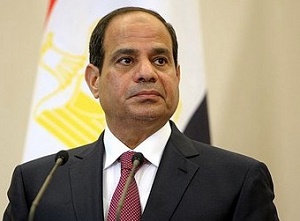
President of Egypt, al-Sisi
The group responsible for assassination of President Sadat was the Egyptian Islamic Jihad spun off from the Muslim Brotherhood. The current top leader of al Qaeda is Ayman al-Zawahiri who used to belong to the Muslim Brotherhood.
The general public did not understand the fact that the Muslim Brotherhood is a socio-religious movement controlled by radicals. People in Egypt came to understand this reality and supported the second Egyptian revolution which gave birth to the government led by President Abdel Fattah el-Sisi. This is a significant and positive development. Recently, the regional headquarters of the Muslim Brotherhood was closed down in Jordan.
In sum, Obama administration’s understanding about the Muslim Brotherhood was wrong. This is the reason why the administration is now forced to reevaluate the U.S. policy toward Middle East.
Aerial bombing campaign and the U.S.-led Coalition of the Willing
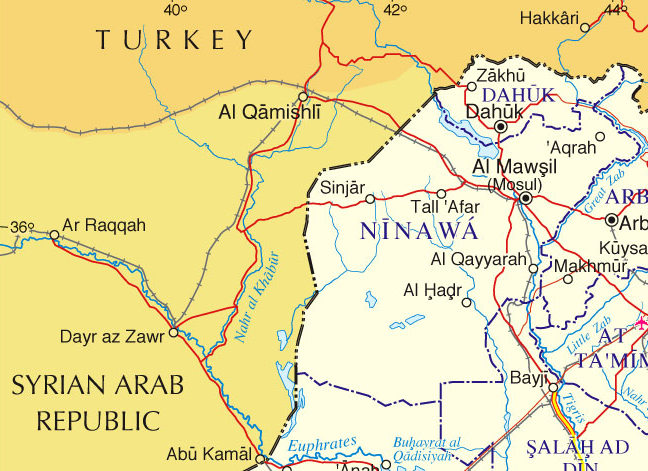
Sinjar is a key junction between Raqqah in Syria and Mosul in Iraq.
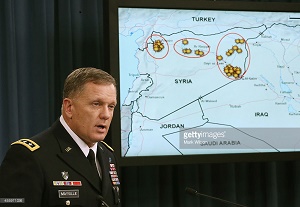
Lt. Gen. William C. Mayville Jr. speaks at Pentagon about the Syrian bombing campaign September 23, 2014 in Washington, DC. Mayville talked about the U.S. and Arab air strikes in Syria against the jihadist group Islamic State in Iraq and Syria (ISIS).
As the United States continued a misguided Middle East policy, ISIL group declared establishment of the Islamic State in territories in Syria and Iraq.
Since Obama administration could not afford any more failures in its Middle East policy, the administration apparently reviewed possible countermeasures against ISIL carefully. Based on the review, the administration decided to adopt the strategy which is composed of “aerial bombings and an international coalition against the Islamic State.”
The first U.S.-led bombing in Iraq was carried out on August 8, 2014 with a state purpose of rescuing Yazidi Christians. The first aerial bombing in Syria was carried out on September 22, 2014 against Raqqa, the capital of ISIL in Syria with participation of five Middle East nations. President Obama emphasized that he “will not allow sanctuary for terrorists,” and launched a “new war against terrorists.””
It was first time since the withdrawal of the U.S. forces from Iraq in December, 2011 that the U.S. government engaged in a military action against ISIL. In helping Iraqi government, the United States patiently waited first for the formation of the national unity cabinet led by Prime Minister Haider Al-Abadi, and then carried out aerial bombings against Sinjar in Iraq near the border with Syria. President Obama started his visits to European nations on September 3, 2014, stated that he would “dismantle and destroy ISIL,” and appealed for “broad coalition” initiative. He further negotiated with Persian Gulf nations led by Saudi Arabia as well as Jordan and carried out aerial bombings in Syria on September 22. President Obama made an appeal to other nations to join the Coalition of the Willing in his speech before the United Nations General Assembly on September 24. The United States succeeded in building up an international partnership with participation of nations from Europe, the U.S., Arab and Islamic nations under the strategy of “aerial bombings and the Coalition of the Willing” as the part of Middle East policy targeting ISIL.
The international coalition against ISIL is bringing some results. In 2015, Ramadi which is a transportation hub in Syria temporarily fell under control of ISIL but was recaptured in December. The coalition forces are aiming to recapture Mosul which is the ISIL capital in Iraq by the end of 2016.
Paris simultaneous terrorist attacks

Police gathering to storm inside an apartment in Saint-Denis, northern suburb of Paris
Multiple terrorist attacks were carried out in Paris simultaneously on November 13, 2015, which killed 130 people and injured more than 350 people. It was reported that 18 terrorists were involved in the attacks and the attacks were the first large-scale coordinated attacks carried out by ISIL outside Islamic regions.
Abdel Bari Atwan explained as follows in his interview with the Yomiuri Shimbun on December 4, 2015. (Summary of his comments are listed.)

Abdel Bari Atwan
(1) ISIL is not an organization controlled by one individual like al Qaeda. A collective leadership has been established, which is composed of former military officers and intelligence officers of the Saddam Hussein regime among others.
(2) Former public servants of the Hussein regime are running day-to-day operations and they include experienced experts on various fields such as taxation, medical care and electricity.
(3) In ISIL scenario to expand their nation, the first phase is expansion and stabilization of its main base territory and the second phase which is terrorist attacks against the United States and Europe was to start only after completion of the first phase. In reality, ISIL was forced to transition to the second phase before completion of the first phase. Paris terrorist attacks signify the transition to a new phase, but it was prematurely carried out much earlier before completion of the first phase.
(4) It is certain that ISIL is under pressure due to the aerial bombing campaign by the U.S.-led Coalition of the Willing. ISIL recently lost control of Sinjar which is a strategic hub in the supply route connecting Mosul and Raqqa where ISIL headquarters are located in Syria.
(5) For financial and military self-sufficiency, ISIL is governing and taxing 10 million residents. ISIL controls 13 oil fields and collects tariff on exports and imports. ISIL is capturing Russian-made weapons from Syrian government forces and high-quality U.S.-made weapons from Iraqi forces.
On September 27, 2015, the French Air Force conducted aerial bombings in Syria for the first time. Even after the terrorist attack on the Charlie Hebdo, a French satirical weekly magazine, by a group of gunmen in January last year, many in the French government were reluctant to start aerial bombings in Syria because of the concerns that attacking ISIL which is fighting the Assad regime would ending up helping the regime. French aerial bombings in Syria were carried out based on a decision which overcame such reluctant attitude. In other words, the Hollande risked its political fortune to launch the war against ISIL terrorists.

France said on Sunday it launched its first air strikes in Syria,destroying an Islamic State training camp in the east of the country. The fighters which carried out the bombing were Rafale(U.S. Navy photo).
In order to frustrate such resolve of the French government, ISIL carried out simultaneous terrorist attacks in Paris. Paris terrorist attacks were a declaration of war against France by ISIL. Suicide bombing terrorist attacks by ISIL fighters represent an ISIL action of war in the highest order.
The international collaboration against ISIL by the Coalition of the Willing was gradually enhanced. Because Turkey enhanced border control efforts, restriction was tightened on the physical distributions, human movement including fighters and flow of funds obtained through oil smugglings in ISIL-controlled territories. France’s participation in the aerial bombing campaign increased already severe pressure on ISIL.
Japan’s more active efforts (other than direct military assistances) beyond humanitarian aid should be proposed
In the wake of Paris terrorist attacks, French President Francois Hollande issued an emergency declaration and announced continuation of aerial bombings. The purpose of aerial bombings is to destroy the enemy which is the ISIL core and the emergency declaration is a war-time domestic counterterrorist measure.
President Obama said, “Although ISIL is not an existential threat to the United States, it is a group of murderers with a skewed Islamic belief. Until we expel ISIL from Syria and Iraq and eventually destroy it, we will continue pursuing the goal energetically. The world community needs to unite against terrorism.”
Likewise, ISIL is certainly not an existential threat to Japan. Japan has been working with the international community and providing humanitarian assistance Japan is good at. It is certain that Japan is highly evaluated by the world community for its foreign policy of proactive contribution to peace a pillar of which is humanitarian assistance. However, Japan should not give an impression that she is pursuing only humanitarian assistance just to fulfill an obligation to the international community.
Japan should offer an in-depth proposal about Japan’s role in destruction of ISIL. There is a high expectation that Japan prepares and proposes a new, broad tactics with input from all experts.
FOOTNOTES
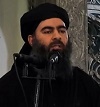
Abu Baker Al-Baghdadi
ISIL: Al Qaeda in Iraq (AQI), Its Jordanian head, Abu Musab al-Zarqawi was killed by the U.S. military bombings in June, 2006. He was a Shiite, considered even foreigners as enemies of God, and repeated indiscriminate terrorist attacks against them. Baghdadi inherited the group, ISIL (Islamic State of Iraq and the Levant) after al-Zarqawi’s death and was responsible for its battles. He was exalted as the caliph of the Islamic State by ISIL on June 29, 2014.
Abdel Bari Atwan
Former editor-in-chief of Al-Quds Al-Arabi, a pan-Arab daily newspaper. Originally from Palestine. Conducted an interview with Osama bin Laden in 1996. Author of the recently published book Islamic State:The Digital Caliphate.
The reality of secular Islam experienced in Uzbekistan (3)
Susumu Fujihashi, journalist
In spite of secularization of Islam in Uzbekistan caused by atheistic education and repression during the Soviet era, Islam has experienced revival since the country’s independence in 1991. As a side effect of Islamic revival, radical Islamic movement is also rising due to the influence from Islamic fundamentalism and radicalism represented by Taliban. In response to this, the Uzbek government led by President Islam Abduganievich Karimov is trying to restrain Islam by thoroughly suppressing radicals on the one hand and by nurturing and supporting moderate Muslims on the other.
After independence, Islamic revival manifested in Uzbekistan
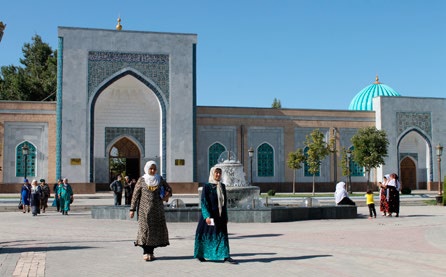
The gate on the entrance path to the mausoleum of Al Bukhari and worshippers
After independence, Islamic revival has been manifested in Uzbekistan as reconstruction and repair of mosques, restoration of tombs and mausoleums of Islamic saints. The tomb of al-Bukhari who compiled hadith with others is located in the suburb of Samarkand. His tomb was improved and transformed into a magnificent mausoleum after independence.
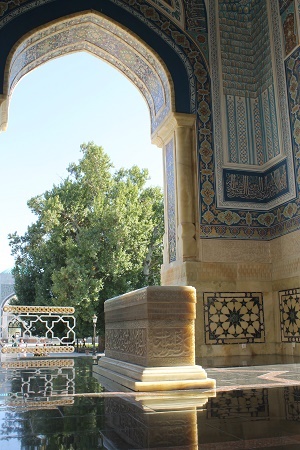
The mausoleum of al Bukhari decorated with beautiful stones. The actual casket is resting underneath the marble casket.
When I visited the site, many male and female worshippers both young and old were there. On vast grounds, a beautifully constructed entrance path continues to the main mausoleum building with a dome atop. The tomb is hidden in the underground of the mausoleum building decorated with beautiful stones. The location of the tomb is marked with a marble casket placed on the marble floor.
Mausoleums and mosques upgraded under the direction of President Karimov
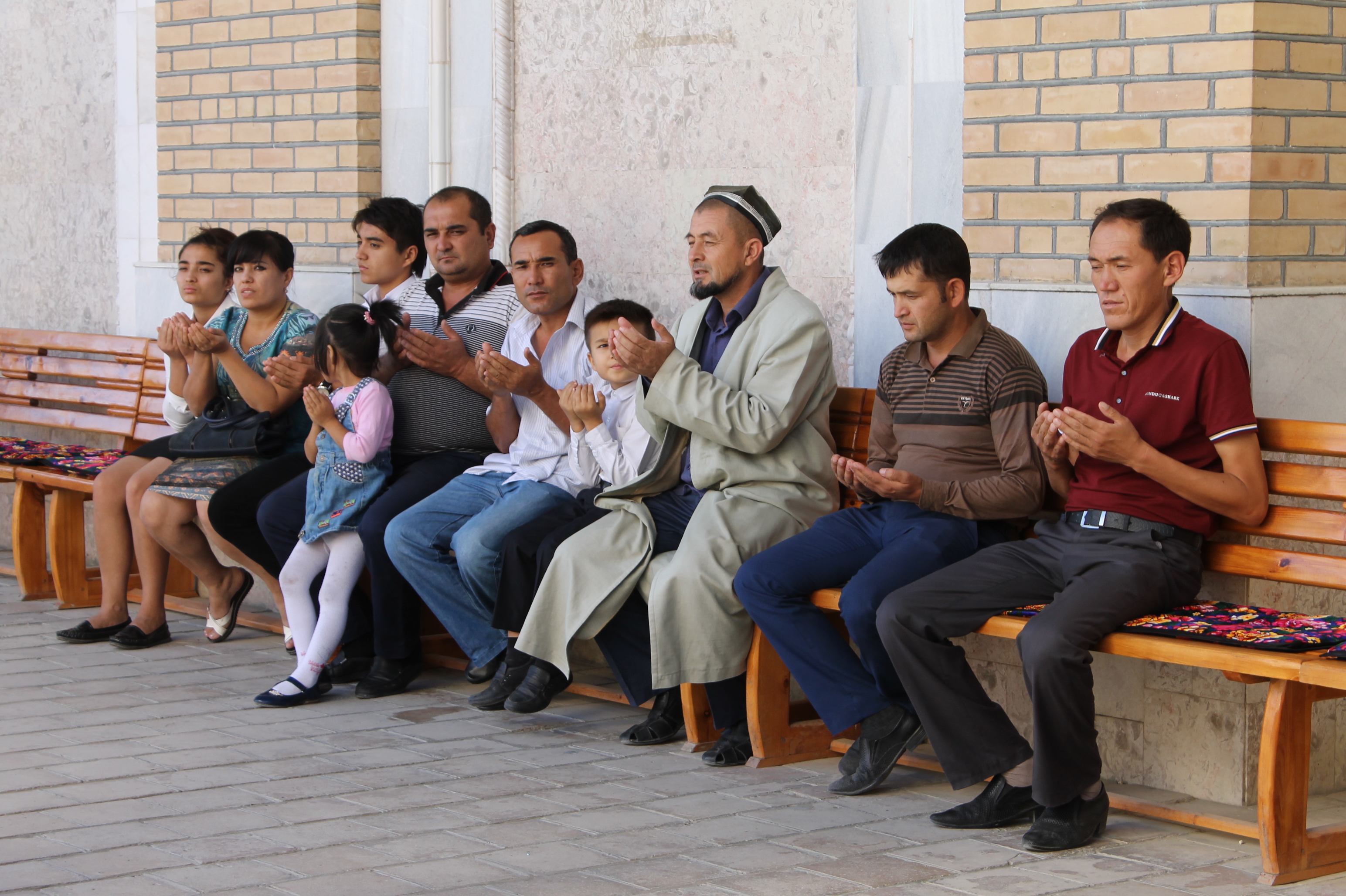
An imam praying for worshippers (third from the right)
“Al Bukhari was blind but his eye sight was restored at the age of 5. He made a pilgrimage to Mecca at the age of 16. He then travels to many places and gathered hadith collections numbering as many as 900,000. He died in 780 A.D. but it is said that when his body was buried in the tomb the body emitted light and nice aroma.”
A religious guide explained life course of al Bukhari to a group of worshippers. Benches are placed by three side walls surrounding the tomb and religious imams pray for worshippers.
More articles available in the electronic “Salaam Quarterly Bulletin”, No.18, May, 2016.
EU and Turkey agree in refugee repatriation
Turkey wants to measure access to Europe — Wary of independent momentum of Kurdish
Takafumi Honda, journalist
Based on agreement signed on March 18 between Europe Union (EU) and Turkey, repatriation of refugees and illegal immigrants from Greece to Turkey began. By this measure, the route of the refugees entering Greece from Turkey is virtually closed. Although refugee flows are expected to be reduced, an ultimate resolution of the problem is far away.
Refugees who arrived in Greece on or after March 20 are to be repatriated. EU instead, accepts Syrian refugees in Turkey in the upper limit of 72,000.
EU policy from acceptance to restriction
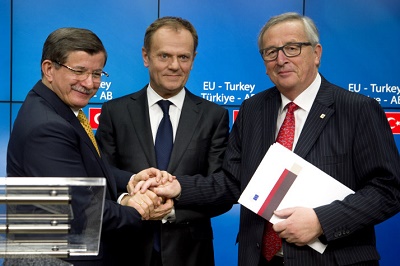
Turkish Prime Minister Ahmet Davutoglu (L) European Council President Donald Tusk (C) and European Commission President, Jean-Claude Juncker during a news conference at the end of a European Union leaders summit in Brussels, Belgium, 18 March 2016. EU leaders and Turkey have agreed a comprehensive plan that opens a safe and legal route to the EU for Syrian refugees while reducing irregular migration. The plan comes into effect on 20 March..
The number of refugees flowing from the Middle East and Africa to the EU in 2015 is about 100 million. According to the UN High Commissioner for Refugees (UNHCR), about half of them are refugees from Syria.
EU has had a basic policy on the surge of refugees caused by intensification of the Syrian civil war that it accepted them. Its leading role was played by the Chancellor Angela Merkel of Germany. EU, however, decided to convert the policy and to suppress the inflow in the form of repatriation by closing the routes because of the growing number of refugees.
The EU and Turkey had agreed an action plan to suppress the refugee influx in November last year. This plan had aimed to make a support of 3 billion euros (about 375 billion yen) to Turkey and to implement the visa exemption for Turkey in October 2016.
However, in the agreement of March this year, this support for Turkey was doubled, and implementation of the visa waiver was moved up to June. In addition, the acceleration of the EU accession negotiations of Turkey is also included. These are, however, only effort goal. Though it seems that the EU side has conceded, when it comes to the execution, there will be many problems.
More articles available in the electronic “Salaam Quarterly Bulletin”, No.18, May 2016.
